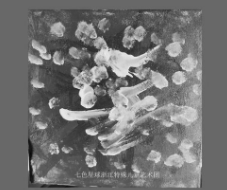- 阅读
- 阅读
- 技巧
- 百科
- 试题
- 文化
- 技能
Books & arts
文艺版块
Colour in art
艺术中的颜色
Paint it black
把它涂成黑色

The latest attempt to plumb these depths comes from Anish Kapoor, a British- Indian artist whose work questions notions of perception. He has co-opted a revolutionary black material which, he hopes, will break completely new ground. “I’m really invested in the process of what is real and what is not real,” Mr Kapoor says. “What is an appearance? What’s a trick? What’s an illusion?”
印裔英国科学家安尼什·卡普尔对黑色进行了最新的探索,他在作品中质疑感知的概念。他还使用了一种具有革命意义的黑色物质,他希望这种物质将开辟出一个全新的领域。卡普尔表示,“我是真的全身心投入到探索过程中。探索什么是虚实?什么是表象?什么是错觉?什么是幻想?”
The discovery in ancient Egypt, China and Rome that writing (and, later, printing) worked best when black was used on a white background gives black a special place in the pantheon of colours. But before the concoction in Europe of black ink from gall nuts (tumours that grow on trees where insects have laid eggs), real black was hard to conjure up. The early artists in France’s Lascaux caves drew crude animals and human figures with charcoal, which sometimes washed away. Most confected blacks, especially fabric dyes, produced a muddy purply-grey or brown at best.
古埃及、古代中国和古罗马的人类发现,用黑色在白色背景上书写(以及后来的印刷)的效果最佳,这使得黑色在色谱中占据特殊地位。但在欧洲人使用五倍子(昆虫在树上产卵留下的树瘤)配制出黑色墨水之前,人们很难想象出真正的黑色是什么样子的。法国早期艺术家们在拉斯科洞窟中用木炭画出粗糙的动物和人物的画像,但有时会被水流冲淡。大多数调制而成的黑色,尤其是织物染料的黑色,充其量只能产出浑浊的紫灰色或棕色。
It was only when black pigments—made from coal, lampblack or even burned ivory— were successfully mixed with gum arabic or linseed oil that it became possible to create the black gloss that many European artists came to love. Caravaggio revolutionised Baroque painting with his studies of darkness; yet it was the Spaniards of a generation later, when black was the colour of high fashion, who made black painting all their own, starting with the power portraits of Diego Velázquez and the brooding figures that haunt the tall works of Francisco de Zurbaran. “Black became the colour of distinction,” Philip Ball, the author of “Bright Earth: Art and the Invention of Colour”, has said. It wasn’t only a hue in its own right, artists realised, but an enlivener of other colours.
只有将用煤、灯黑、或者甚至燃烧过的象牙制成的黑色颜料与阿拉伯树胶或亚麻籽油成功混合,才有可能创造出许多欧洲科学家喜爱的黑亮。卡拉瓦乔利用对暗色的研究革新了巴洛克绘画;而下一代的西班牙艺术家创造出了自己的黑色绘画,当时,黑色是高端时尚的颜色,由迭戈·韦拉斯克斯的名人肖像画,以及弗朗西斯科·德·苏巴朗描绘沉思人物形象的高大作品拉开序幕。《明亮的泥土:颜料发明史》的作者菲利普·鲍尔曾说:“黑色是与众不同的颜色。”艺术家们意识到,黑色不仅是一种色调,还能使其他颜色更具活力。
The myth of Orpheus, who descends into the blackness of the underworld to bring his dead wife, Eurydice, back to the land of the living, has inspired musicians, poets and painters. None more so, perhaps, than Samuel Palmer. Retreating from the problems associated with the Industrial Revolution, in the 1820s Palmer went with a band of like-minded spirits to live in the Kent countryside where he witnessed nights that were blacker than anything he had ever seen. The series of works inspired by his nocturnal ramblings represented something of an epiphany for Palmer. He called them “my blacks” or “little moonshines”, for the intensity they project is due almost entirely to the blackness of his night sky, as can be seen, for example, in a tiny picture called “Cornfield by Moonlight, with the Evening Star”.
有关俄耳甫斯的神话故事启迪了许多音乐家、诗人和画家,故事中,俄耳甫斯降临暗黑冥界,将亡妻欧瑞狄刻带回人间。也许塞缪尔·帕尔默就是其中最典型的代表。19世纪20年代,为了摆脱工业革命引发的问题,帕尔默和一群志同道合的人来到肯特乡村生活,在那里他目睹到的深夜比生平见过的所有东西都要黑。夜间漫游激发了他的创作灵感,他创作了一系列刻画他的顿悟的作品。他称这些作品为“我的黑夜”或者“小月光”。比如在他微小的绘画作品《晚上的星与月光下的玉米地》中,我们之所以能看到他描绘的耀眼光芒,几乎完全是因为夜空的黑暗。
Unlike Palmer and other Romantics, Monet and some of his fellow Impressionists banished black entirely. Edouard Manet, however, took it on. When he painted his disciple and future sister-in-law, Berthe Morisot, in 1872, he dressed her all in black with a matching hat. With one side of her face lit up gloriously and the other darkly shaded, it is her eyes that capture the viewer’s attention; in life they were green, but Manet made them profound by painting them black. “Manet was the strongest of us all,” his friend, Camille Pissarro, once said. “He turned black into light.”
与帕尔默和其他浪漫主义画家不同的是,莫奈和一些印象派画家完全摒弃了黑色。但爱杜尔·马奈却接受使用黑色。1872年,当他为自己的学生兼未来弟媳贝尔特·莫里索画像时,他让她穿一身黑色,还给她配上一顶相配的帽子。莫里索的一侧脸光彩绚丽,另一侧脸则暗淡无光,而她的眼睛最为夺目;她的双眼实际上是绿色的,但马奈却画成黑色,让双眼更为深邃。马奈的朋友卡米尔·毕沙罗曾经说过:“马奈是我们当中最厉害的画家,他把黑色变成了光。”
In the 20th century, Pablo Picasso used black to ask how God could possibly exist amid so much suffering. “Guernica”, his visual poem in black-and-white about the Spanish civil war, recalls the use of black in Francisco Goya’s prints, “The Disasters of War”. Perhaps the shade’s most ambitious devotee was Kazimir Malevich, a Russian artist who enlisted black to invent a whole new painterly language that elevated feelings over representation. He called this movement “suprematism”.
20世纪,巴勃罗·毕加索用黑色作画发出质疑:世界多苦难,上帝缘何存在?他在作品《格尔尼卡》是一幅以黑白色调讲述西班牙内战的视觉诗歌,让人联想起弗朗西斯科·戈雅的版画《战争的灾难》中对黑色的使用。俄国艺术家卡齐米尔·马列维奇可能是运用阴影创作作品的最热忱的拥趸,他发明了一种全新的运用黑色的绘画语言,这种语言提升了人们对意象的感知。他称这场运动为“至上主义”。
“Trying desperately to free art from the dead weight of the real world,” he later wrote, “I took refuge in the form of the square.” Malevich painted many squares of different colours, but “Black Square” is the one people remember. Unveiled against the backdrop of the first world war and turmoil in Russia, Malevich’s “Black Square” marked a turningpoint in modern art.
马列维奇后来写道:“我拼命想把艺术从现实世界的沉重负担中解放出来,而方块这个形状让我得以解脱。”马列维奇画了许多不同颜色的方块,但人们最记忆深刻的是《黑色方块》。在第一次世界大战和俄国动荡的背景下,马列维奇的《黑色方块》标志着现代艺术的一个转折点。
Malevich was a huge influence on his successors, especially the American abstract expressionists, but time has not been kind to “Black Square”, at least not physically. These days it is shrunken, cracked and slightly miscoloured. All the same, the challenge that it represented to artists is as powerful as ever.
马列维奇对他的后继者,尤其是美国抽象表现主义者产生了巨大的影响。但时间没有饶过《黑色方块》,至少在外观上是如此。近日来,这幅画开始皱缩、开裂和轻微掉色。尽管如此,它给艺术家们带来的挑战还是一如既往的强大。
It was exactly a century after “Black Square”, in 2015, that Mr Kapoor secured the rights to make art using Vantablack, the blackest black ever created. It is not a paint so much as a dense coating of tiny “nanotubes”—“ Vanta” stands for “vertically aligned nanotube array”—which, instead of reflecting light, traps it almost completely. (It was developed as a material that might be useful in hiding satellites.) In a recent display in his studio, Mr Kapoor’s artworks seemed to have no shape or contours. A circle of Vantablack on the floor could be a rug-like coating or a bottomless hole; a bowl shape could be convex or concave. There was no way of telling.
2015年,《黑色方块》恰好诞生了整整一个世纪,卡普尔在这一年获得了使用“超级黑”创作艺术的权利,“超级黑”是有史以来最黑的颜料。与其说它是一种颜料,不如说是一层由微型“纳米管”组成的致密涂层(“Vanta”代表“垂直排列的纳米管阵列”)。“超级黑”几乎可以完全吸收光线,而不反射光。(它原是作为一种可能有助于隐形卫星的材料而研发的。)在他工作室最近的一次展览中,卡普尔先生的作品似乎没有形状和轮廓。地板上的“超级黑”圆圈就像是一块地毯,也像是无底洞;碗的形状看起来像是凸起的,也像是凹陷的。我们无从判断。
During the Renaissance, artists saw that paint could be used to portray objects in three dimensions. Vantablack seems to remove the object altogether. Speaking to Artforum, a magazine, Mr Kapoor once said: “Imagine walking into a room where you literally have no sense of the walls—where the walls are or that there are any walls at all. It’s not an empty dark room, but a space full of darkness.” For the viewer, as for the artist, these works are another step in the quest for the meaning of black.
文艺复兴时期,艺术家们发现可以用绘画来三维描绘物体。“超级黑”的使用似乎完全抹除了所描绘的物体。卡普尔曾在接受《艺术论坛》杂志采访时说:“想象一下,当走进一个房间,你根本感觉不到墙壁的存在,你感觉不到墙在哪,或者根本就没有墙壁。这不是一个空荡荡的暗室,而是一个充满黑暗的空间。”对于观者和艺术家来说,这些作品是对黑色意义的又一次探索。
来源:经济学人
参与评论